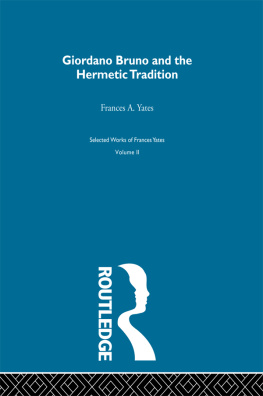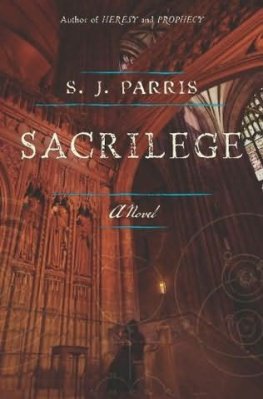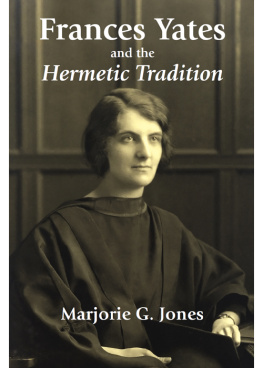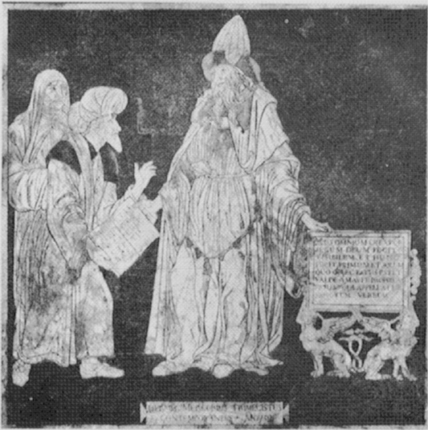FRANCES YATES
SELECTED WORKS
FRANCES YATES
Selected Works
VOLUME I
The Valois Tapestries
VOLUME II
Giordano Bruno and the Hermetic Tradition
VOLUME III
The Art of Memory
VOLUME IV
The Rosicrucian Enlightenment
VOLUME V
Astraea
VOLUME VI
Shakespeare's Last Plays
VOLUME VII
The Occult Philosophy in the Elizabethan Age
VOLUME VIII
Lull and Bruno
VOLUME IX
Renaissance and Reform: The Italian Contribution
VOLUME X
Ideas and Ideals in the North European Renaissance
FRANCES YATES
Selected Works
Volume II
Giordano Bruno and the
Hermetic Tradition

First published 1964 by Routledge
Reprinted by Routledge 1999, 2001
2 Park Square, Milton Park,
Abingdon, Oxon, OX14 4RN
Simultaneously published in the USA and Canada
by Routledge
270 Madison Ave, New York NY 10016
Transferred to Digital Printing 2007
Routledge is an imprint of the Taylor & Frands Group
1964 Frances A. Yates
Publisher's note
The publisher has gone to great lenghts to ensure the
quality of this reprint but points out that some imperfections
in the original book may be apparent.
British Library Cataloguing in Publication Data
A CIP record of this set is available from the British Library
Library of Congress Cataloging in Publication Data
A catalogue record for this book has been requested
ISBN 0-415-22045-9 (Volume 2)
10Volumes: ISBN 0-415-22043-2 (Set)
GIORDANO BRUNO
AND THE HERMETIC TRADITION
GIORDANO BRUNO
AND THE
HERMETIC TRADITION
by
FRANCES A. YATES

First published 1964
by Routledge
2 Park Square, Milton Park,
Abingdon, Oxon, OX14 4RN
Reprinted 1971
Frances A. Yates 1964
No part of this book may be reproduced
in any form without prior permission from
the publisher, except for the quotation
of brief passages in criticism
ISBN 0 7100 2337 5
CONTENTS
ILLUSTRATIONS
(b) The first Decan of Aries
Francesco del Cossa, Palazzo Schifanoja, Ferrara (photos: Villani) at page
(d) Zoemetra
Figures from Giordano Bruno, Articuli centum et sexaginta adversus huius tempestatis mathematicos atque philosophos, Prague, 1588 (photos: Bibl. Nat. Paris) at page
(d) Expansor
Figures from Giordano Bruno, Articuli adversus mathmaticos, Prague, 1588 (photos: Bibl. Nat. Paris)
MANY years ago I planned to make an English translation of Giordano Bruno's La cena de le ceneri with an introduction emphasising the boldness with which this advanced philosopher of the Renaissance accepted the Copernican theory. But as I followed Bruno along the Strand to the house in Whitehall where he was to expound the Copernican theory to knights and doctors, doubts arose. Was that journey imaginary and was the Supper really held at the French embassy? And was the Copernican theory really the subject of the debate or was there something else implied in it? The Bruno problem remained with me thereafter as the real centre of all my studies; masses of notes and manuscript accumulated but full understanding eluded me. Some major clue was missing.
During the last twenty-five years certain scholars have been drawing attention to the significance of the influence of Hermetism in the Italian Renaissance. The fundamental bibliographical studies of P. O. Kristeller have shown the importance and diffusion of Ficino's translation of the Corpus Hermeticum. E. Garin has subtly indicated Hermetic strands in Renaissance thought, particularly in his Medioevo e Rinascimento and in essays now republished in the book La cultura filosofica del Rinascimento italiano. He also inspired a group of students to undertake detailed investigations of Hermetic influence on individual writers, published as Testi umanistici su l'ermetismo. Several French scholars are aware of Renaissance Hermetism. In England, D. P. Walker has examined the prisca theologia in an important article, and has analysed Ficino's use of the Hermetic Asclepius in his book Spiritual and Demonic Magic from Ficino to Campanella. This book brings out for the first time shades of difference in Renaissance attitudes to magic and indicates the bearing of the subject on religious issues.
No one had as yet spoken of Bruno in connection with Hermetism, nor, in spite of my interest in all these studies, did the possibility of such a connection occur to me for some time. I had long known that Bruno's works, particularly those on memory, are full of magic (a fact which did not escape Lynn Thorndike in his History of Magic and Experimental Science), but I did not realise that his magic belongs with his philosophy as part of a Hermetic philosophy. It was not until a few years ago that it dawned upon me, quite suddenly, that Renaissance Hermetism provides the long-sought-for major clue to Bruno. The right key was found at last; my former Bruno studies fell into place; and this book was written fairly quickly.
It is obvious that the book is not a monograph on Bruno; it sets out to do only what its title states, to place him in the Hermetic tradition. Before a final reassessment of Bruno is possible other studies are necessary, particularly an elucidation of his place in the history of the classical art of memory which he transformed into a magico-religious technique. Some of the references to Bruno's mnemonics in the present book may seem rather obscure, but I hope to treat further of this subject in another book. There is a great omission in this book, namely the influence on Bruno of Ramon Lull which I have hardly mentioned, nor have I used his many works on Lullism. Here again a study of Bruno and the Lullian tradition is needed which one day I hope that I may be able to produce. The three strands of the Hermetism, the mnemonics, the Lullism are all interwoven in Bruno's complex personality, mind, and mission. All three have a history running from the Middle Ages through the Renaissance up to the dividing line of Descartes and the seventeenth century.
I am indebted throughout the present book to the Nock-Festugire edition and French translation of the Corpus Hermeticum and to A.-J. Festugire's book La Rvlation d' Herms Trismgiste. Though Renaissance Hermetism has not been set out before in the way in which I attempt to do it in the first ten chapters, these chapters owe much to others, particularly in parts of IV, VII, IX, and X to Walker; the theme of VIII has been hinted at by Garin. My knowledge of Cabala is derived almost entirely from the works of G. G. Scholem; my persistence in spelling the word in this way is part of the general plan of approaching the ancient wisdoms from the point of view of the Renaissance; this is how Pico and Bruno spell it. The nine chapters on Bruno present him as a variation on the Hermetic-Cabalist tradition. This is so revolutionary that I have not been able to use much of the vast literature on Bruno, save for biographical and documentary material and some other works which are acknowledged in the notes, I have used G. Aquilecchia's revised edition of the Gentile edition of Bruno's Italian dialogues, and Aquilecchia's edition of the two newly discovered Latin works. The treatment of Campanella as a sequel to Bruno is new, though indebted to Walker's analysis of Campanula's magic and to the labours of L. Firpo. The last two chapters emphasise the weakening of Hermetic influence through the dating of the
Next page









![Bruno Skvorc [Bruno Skvorc] - Build Your First Ethereum DApp](/uploads/posts/book/119691/thumbs/bruno-skvorc-bruno-skvorc-build-your-first.jpg)


